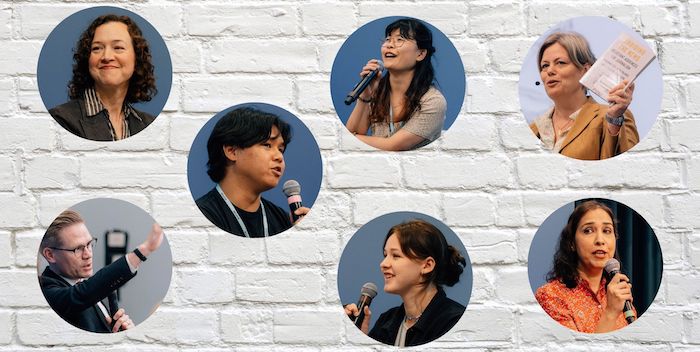The Post’s British chief executive, Will Lewis, who assumed the mantle in January, reportedly told staff members last Monday that: “I’m not interested in managing decline. I’m interested in growth,” according to a recording of the meeting. “We are losing large amounts of money. Your audience has halved in recent years. People are not reading your stuff.”
“It is getting harder to sell journalism. The market has changed. Our competitors are not only the other paper down the street,” Amalie Kestler, managing editor in chief of Politiken in Denmark, told attendees at a packed session on news avoidance at WAN-IFRA’s 75th World News Media Congress in Copenhagen.
“As journalists and media professionals, we face the challenge of capturing the attention of those who actively avoid the very news that we work so hard to produce.”
Reasons for this became clearer as experts and Gen Z’ers shared experiences, insights – and much-needed guidance on how to counter apathy and avoidance.
Why people avoid news – and why it matters
Dr. Ruth Palmer, co-author of Avoiding the News: Reluctant Audiences for Journalism, with Benjamin Toff and fellow panellist Rasmus Kleis Nielsen, presented findings from their exhaustive, 4-year study into the cause and effect of this growing phenomenon.
“Our approach is to focus on the news avoiders themselves, and how they experience their relationship to news – not news producers or the news content,” she explained.
Their key findings, she says, is essentially, the thesis of the book: “News content matters, but so do these three I’s. Our identities – who we are, what we believe – our ideologies, and the infrastructures that we use to engage with information; combined, these three act as a filter through which we experience our relationship to news.”

Palmer, who is an associate professor of communication and digital media at IE University in Spain, stressed that news avoidance is on the increase, and, “Because news avoidance and perhaps other signs of the fraying social contract between news and much of the public is only partly about content, the solution can’t just be more content.”
Meeting audience needs – where audiences are, from an audience perspective
According to Avoiding the News, consistent news avoiders tend to be among segments of society that are socially and politically disadvantaged – such as women, younger people, and those from lower socioeconomic classes.
Co-author Rasmus Kleis Nielsen, Director, Reuters Institute for the Study of Journalism, UK – due to join the University of Copenhagen as a Professor in the Department of Communication in October – believes it’s important to recognise “how much of news doesn’t make any real effort to represent or reflect gender, class, religion, age.”
“We learned about what it means to meet people where they are, and the mobile phone is a remote control to life – if journos want to serve the public, to reach them, you literally have to be where they are – and that is on platforms; more than half the public is not coming to your site and apps,” he noted.
“If you want to empower people with knowledge, you have to start with what they want to do – it has to start with their point of view, not your point of view.”
Findings from a new study by the Pew Research Center, on How Americans Get News on TikTok, X, Facebook and Instagram, released this week, show how people get their news from different sources, across different platforms:
‘News consumers on TikTok are more likely than those on other sites to get news from influencers or celebrities, while those on Facebook and Instagram are more likely to get it from family, friends and acquaintances.’
Ideas from Avoiding the News: Five ways journalists and editors can tackle consistent news avoidance
1 Respond to how news feels to people, which in a lot of cases is not good.
2 Take communities and identities seriously
3 Package content for consistent news avoiders.
4 Communicate the role of journalism through news media literacy, and
5 Reaffirm editorial values and professional standards, which consistent news avoiders do not generally appreciate; they don’t see a big difference between news and the other information that’s out there.
Guidelines from GenZ
Students from the International People’s College in Elsinore, Denmark, who had participated in a Global Youth News Lab workshop that ultimately presented 7 Global Youth News Values at this World News Media Congress session, weighed in with their news preferences – providing valuable insights to news leaders keen on reaching younger audiences.

Haruka Kobayashi, from the United Kingdom, wants G•local news – news that connects local to global. “We are an ever-more connected generation, in digital and travel, and we do care. The world is connected, and we actively engage in local politics, but it’s important to see how my local events impact the bigger picture, and why I should care.
Traditional news media IS doing a great job, but needs to emphasise the value of proximity – and the fact that few of us have TV; most are on mobile platforms.

Lilly Anuk Bosse, from Germany, grew up with a strong connection to daily news, which faltered in her teens. “Now, I’ve been trying to reconnect but it is different, and difficult, as traditional news seems a little boring, and not as suited to our attention span and speed of life, as social media is – fast, with big pics and little info.
“We’d like to see more Human stories. News always features the same people, all the time – white, or men, or both. We don’t really need celebrities in the news, because we can access their feeds; it’s important to spotlight others, who are unknown and unheard.”

Miko Nerviol from the Philippines, wants news that Empowers.
”The biggest barrier to news is that there’s too much of it. It just feels numbing to read the news these days, as it sems to be the same thing that happens over and over again – another flooding, or another shooting, another death. It’s depressing. You could use some more uplifting stories, focus on positive activity, and solutions.
The Copenhagen Criteria
The Copenhagen Criteria is the updated news values, defined by a group of 70 international students, partnered with global news leaders and journalists, to provide news producers with guiding values when producing news products for young audiences.
.

This story was first published by the World Association of News Publishers (WAN-IFRA).
Lucinda Jordaan is a WAN-IFRA correspondent in Africa.
Join the World Association of News Publishers here.















